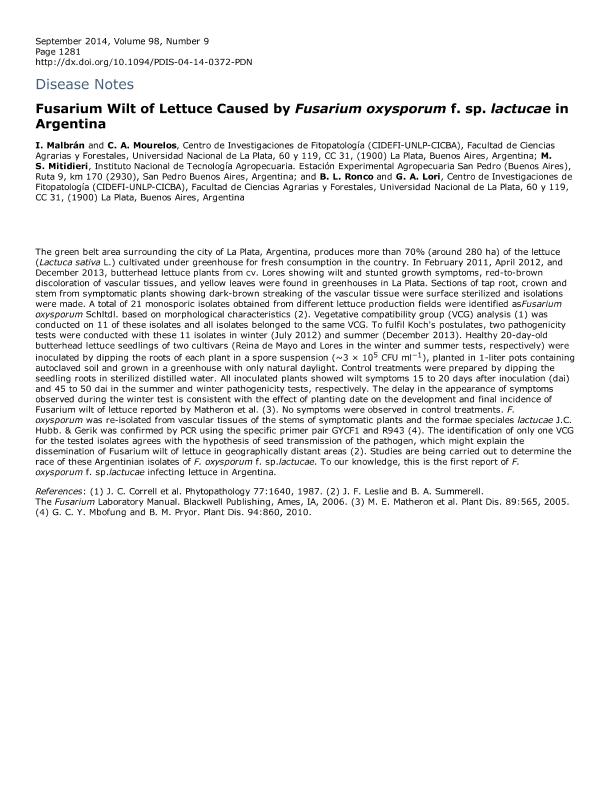Mostrar el registro sencillo del ítem
dc.contributor.author
Malbrán, Ismael

dc.contributor.author
Mourelos, Cecilia Alejandra

dc.contributor.author
Mitidieri, Mariel Silvina

dc.contributor.author
Ronco, B. L.
dc.contributor.author
Lori, Gladys

dc.date.available
2018-01-08T17:57:44Z
dc.date.issued
2014-05
dc.identifier.citation
Mitidieri, Mariel Silvina; Malbrán, Ismael; Lori, Gladys; Ronco, B. L.; Mourelos, Cecilia Alejandra; Fusarium Wilt of Lettuce Caused by Fusarium oxysporum f. sp. lactucae in Argentina; American Phytopathological Society; Plant Disease; 98; 9; 5-2014; 1281
dc.identifier.issn
0191-2917
dc.identifier.uri
http://hdl.handle.net/11336/32530
dc.description.abstract
The green belt area surrounding the city of La Plata, Argentina, produces more than 70% (around 280 ha) of the lettuce (Lactuca sativa L.) cultivated under greenhouse for fresh consumption in the country. In February 2011, April 2012 and December 2013, butterhead lettuce plants from cv. Lores showing wilt and stunted growth symptoms, red-to-brown discoloration of vascular tissues and yellow leaves were found in greenhouses in La Plata. Sections of tap root, crown and stem from symptomatic plants showing dark-brown streaking of the vascular tissue were surface sterilized and isolations were made. A total of 21 monosporic isolates obtained from different lettuce production fields were identified as Fusarium oxysporum Schltdl. based on morphological characteristics (2). Vegetative compatibility group (VCG) analysis (1) was conducted on 11 of these isolates and all isolates belonged to the same VCG. To fulfil Koch?s postulates, two pathogenicity tests were conducted with these 11 isolates in winter (July 2012) and summer (December 2013). Healthy 20-day-old butterhead lettuce seedlings of two cultivars (Reina de Mayo and Lores in the winter and summer tests, respectively) were inoculated by dipping the roots of each plant in a spore suspensión (≈ 3 × 105 CFU mL-1), planted in 1 L pots containing autoclaved 26 soil and grown in a greenhousewith only natural daylight. Control treatments were prepared by dipping the seedling roots insterilized distilled water. All inoculated plants showed wilt symptoms 15 to 20 days after inoculation (dai) and 45 to 50 dai in the summer and winter pathogenicity tests, respectively. The delay in the appearance of symptoms observed during the winter test is consistent with the effect of planting date on the development and final incidence of Fusarium wilt of lettuce reported by Matheron et al. (3). No symptoms were observed in control treatments. F. oxysporum was reisolatedfrom vascular tissues of the stems of symptomatic plants and the formae speciales lactucae J.C. Hubb. & Gerik was confirmed by polymerase chain reaction (PCR) using the specific primer pair GYCF1 and R943 (4). The identification of only one VCG for the tested isolates agrees with the hypothesis of seed transmission of the pathogen, which might explain the dissemination of Fusarium wilt of lettuce in geographically distant areas (2). Studies are being carried out to determine the race of these Argentinian isolates of F. oxysporum f. sp. lactucae. To our knowledge, this is the first report of F. oxysporum f. sp. lactucae infecting lettuce in Argentina.
dc.format
application/pdf
dc.language.iso
eng
dc.publisher
American Phytopathological Society

dc.rights
info:eu-repo/semantics/openAccess
dc.rights.uri
https://creativecommons.org/licenses/by-nc-sa/2.5/ar/
dc.subject
Lettuce
dc.subject
Fusarium Wilt
dc.subject.classification
Meteorología y Ciencias Atmosféricas

dc.subject.classification
Ciencias de la Tierra y relacionadas con el Medio Ambiente

dc.subject.classification
CIENCIAS NATURALES Y EXACTAS

dc.title
Fusarium Wilt of Lettuce Caused by Fusarium oxysporum f. sp. lactucae in Argentina
dc.type
info:eu-repo/semantics/article
dc.type
info:ar-repo/semantics/artículo
dc.type
info:eu-repo/semantics/publishedVersion
dc.date.updated
2017-12-26T14:32:00Z
dc.journal.volume
98
dc.journal.number
9
dc.journal.pagination
1281
dc.journal.pais
Estados Unidos

dc.journal.ciudad
Minnesota
dc.description.fil
Fil: Malbrán, Ismael. Universidad Nacional de la Plata. Facultad de Ciencias Agrarias y Forestales. Departamento de Ciencias Biológicas. Centro de Investigaciones de Fitopatología. Provincia de Buenos Aires. Gobernación. Comision de Investigaciones Científicas. Centro de Investigaciones de Fitopatología; Argentina
dc.description.fil
Fil: Mourelos, Cecilia Alejandra. Universidad Nacional de la Plata. Facultad de Ciencias Agrarias y Forestales. Departamento de Ciencias Biológicas. Centro de Investigaciones de Fitopatología. Provincia de Buenos Aires. Gobernación. Comision de Investigaciones Científicas. Centro de Investigaciones de Fitopatología; Argentina
dc.description.fil
Fil: Mitidieri, Mariel Silvina. Instituto Nacional de Tecnología Agropecuaria. Centro Regional Buenos Aires Norte. Estación Experimental Agropecuaria San Pedro; Argentina
dc.description.fil
Fil: Ronco, B. L.. Universidad Nacional de la Plata. Facultad de Ciencias Agrarias y Forestales. Departamento de Ciencias Biológicas. Centro de Investigaciones de Fitopatología. Provincia de Buenos Aires. Gobernación. Comision de Investigaciones Científicas. Centro de Investigaciones de Fitopatología; Argentina
dc.description.fil
Fil: Lori, Gladys. Universidad Nacional de la Plata. Facultad de Ciencias Agrarias y Forestales. Departamento de Ciencias Biológicas. Centro de Investigaciones de Fitopatología. Provincia de Buenos Aires. Gobernación. Comision de Investigaciones Científicas. Centro de Investigaciones de Fitopatología; Argentina
dc.journal.title
Plant Disease

dc.relation.alternativeid
info:eu-repo/semantics/altIdentifier/doi/http://dx.doi.org/10.1094/PDIS-04-14-0372-PDN
dc.relation.alternativeid
info:eu-repo/semantics/altIdentifier/url/https://apsjournals.apsnet.org/doi/10.1094/PDIS-04-14-0372-PDN
Archivos asociados
